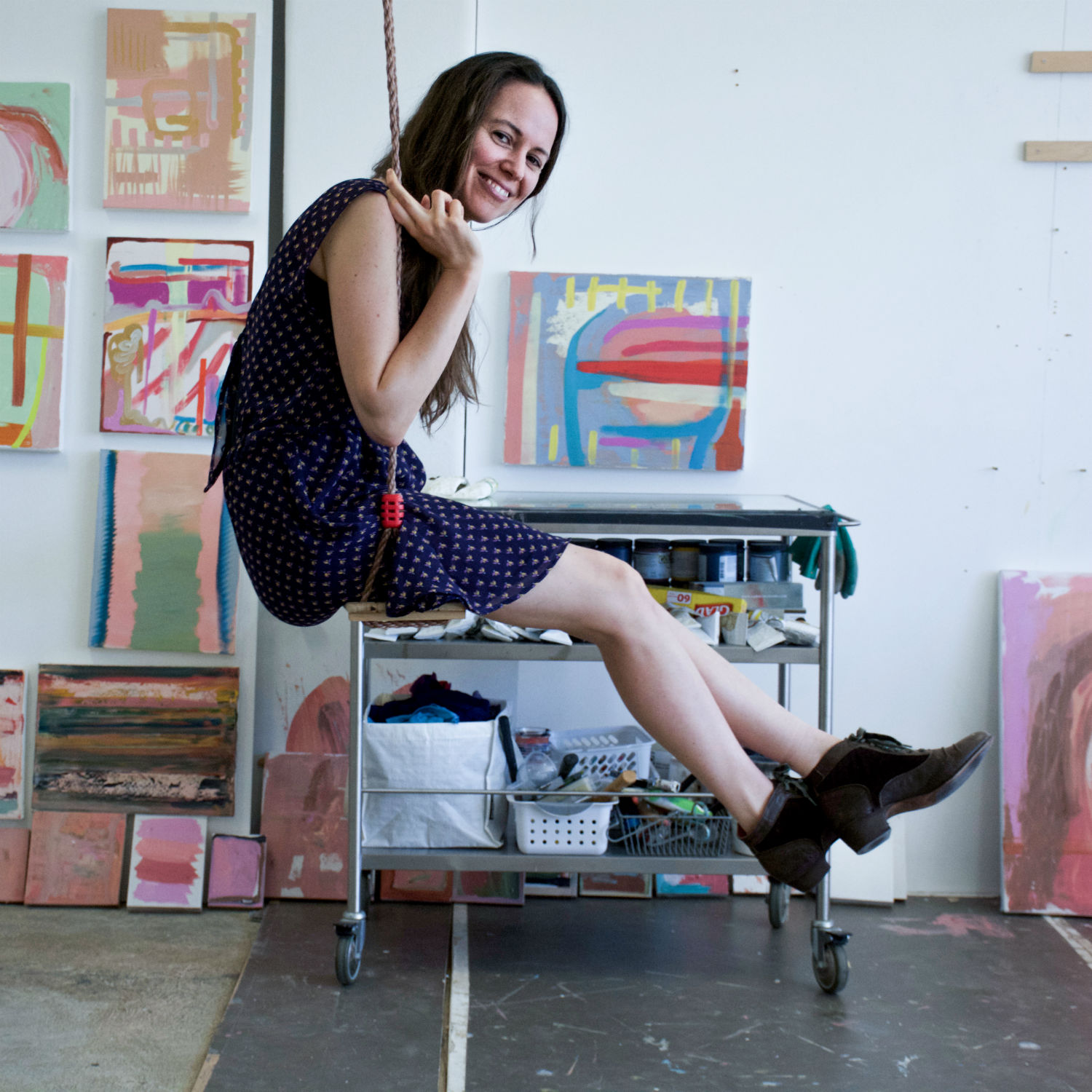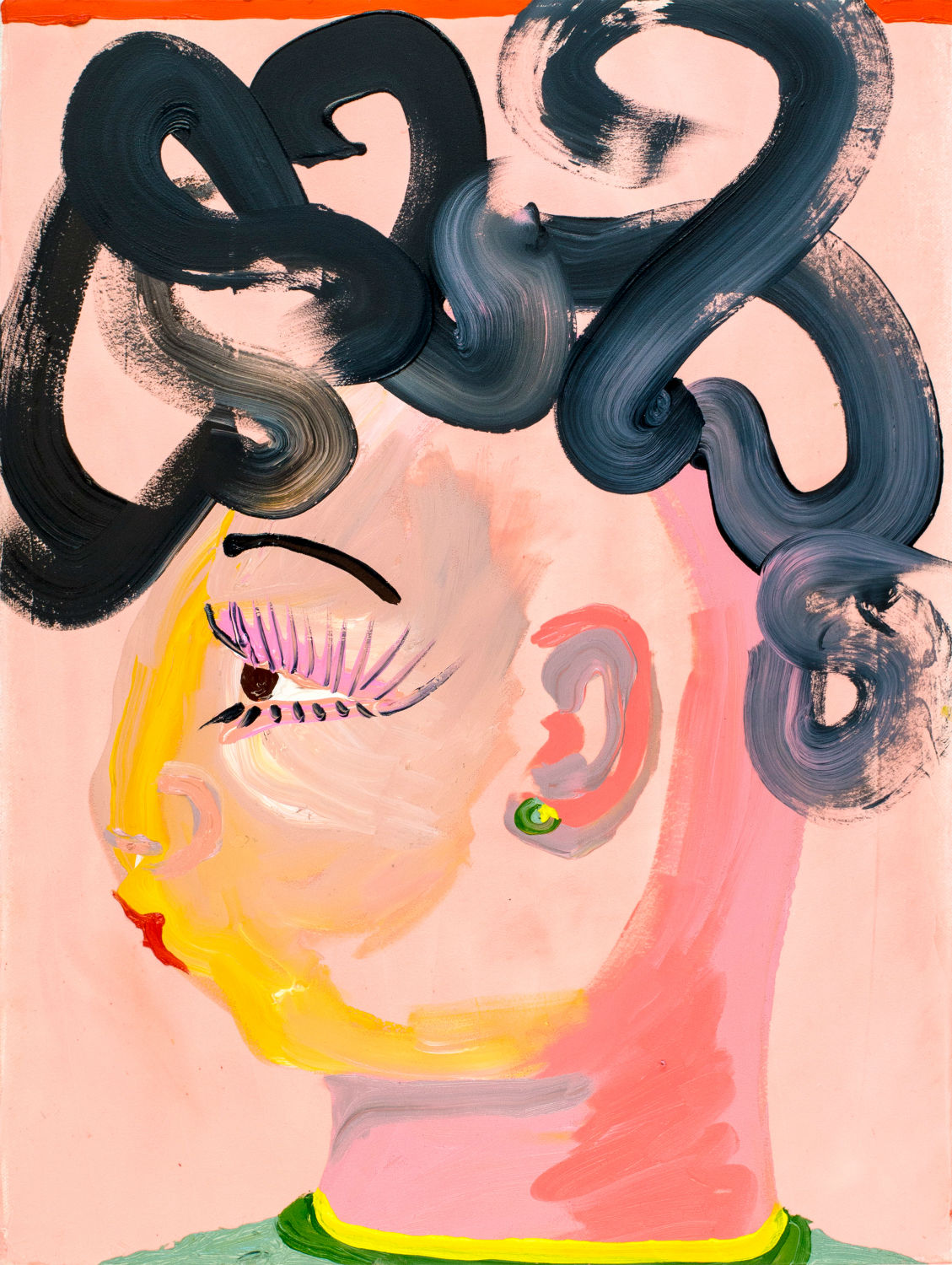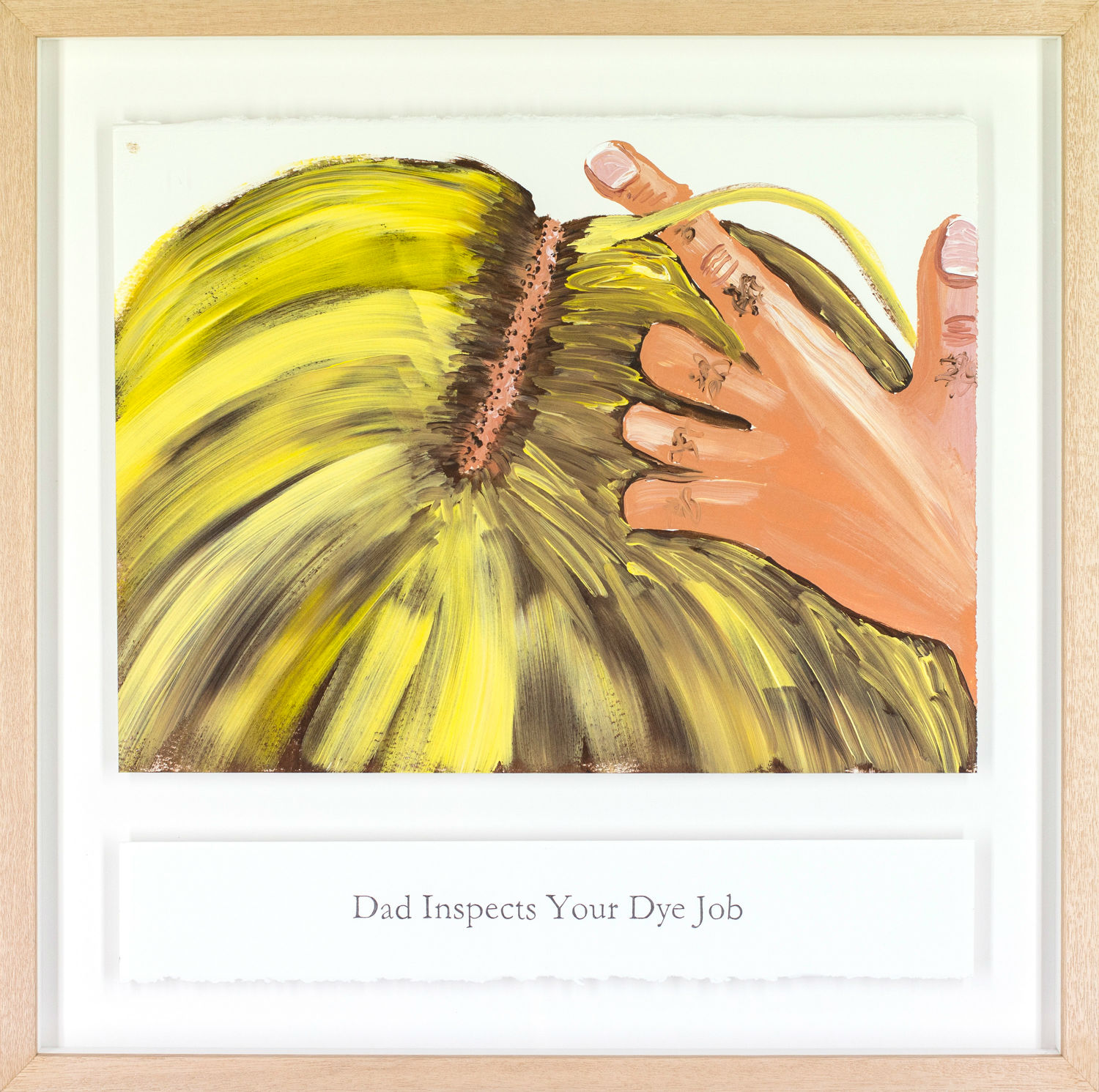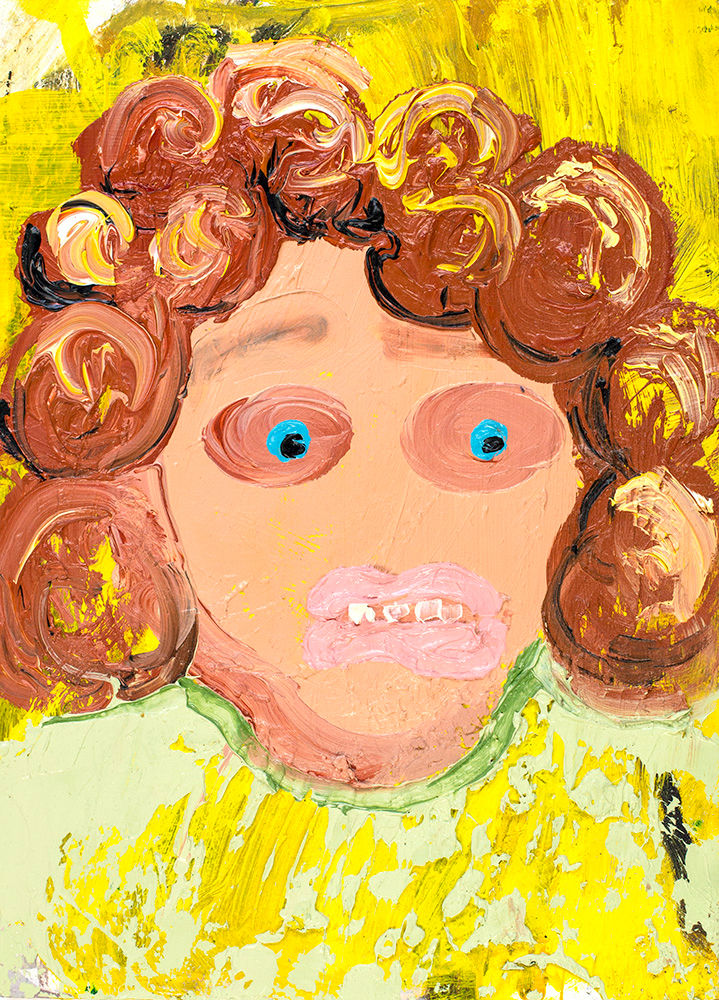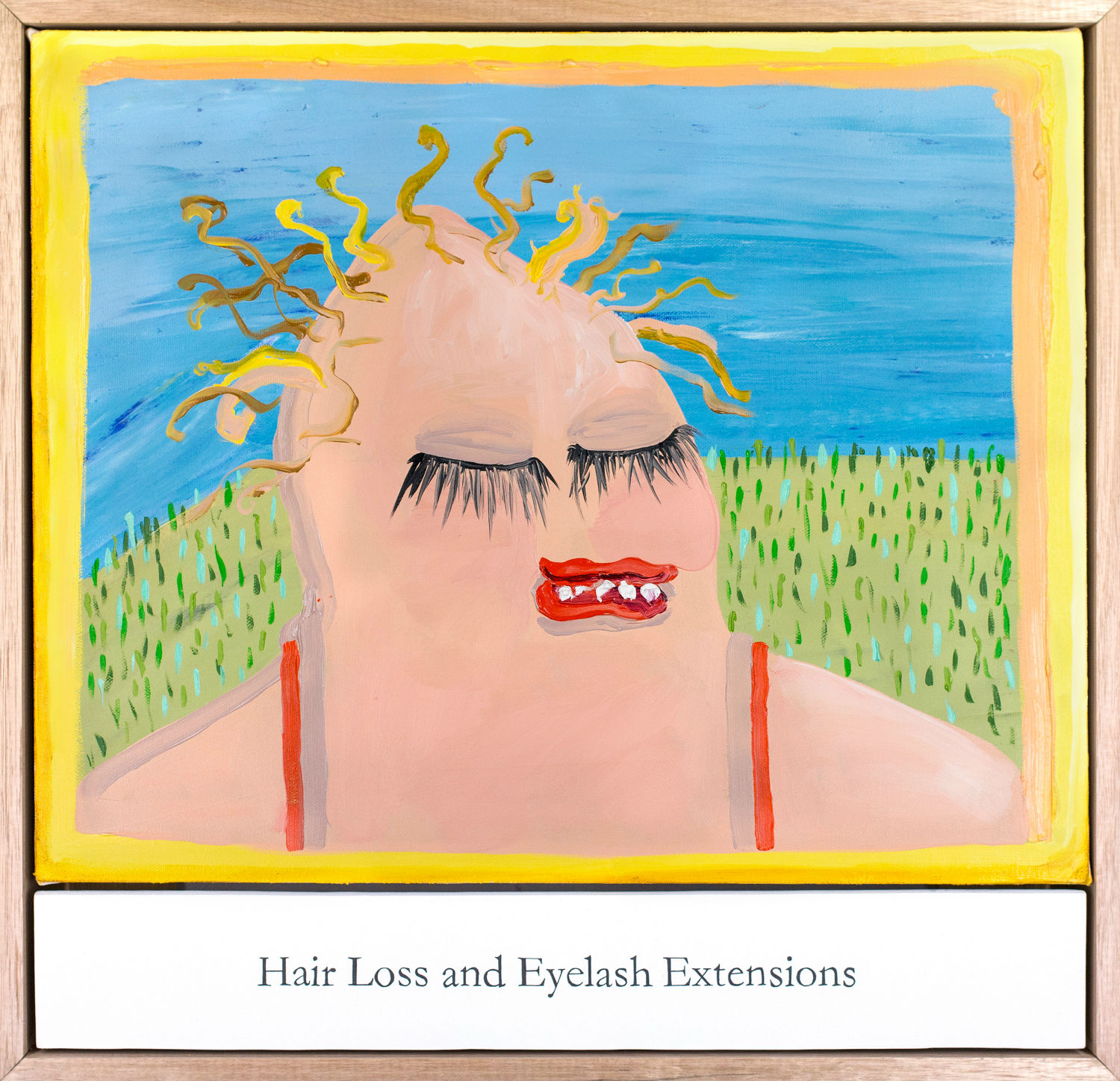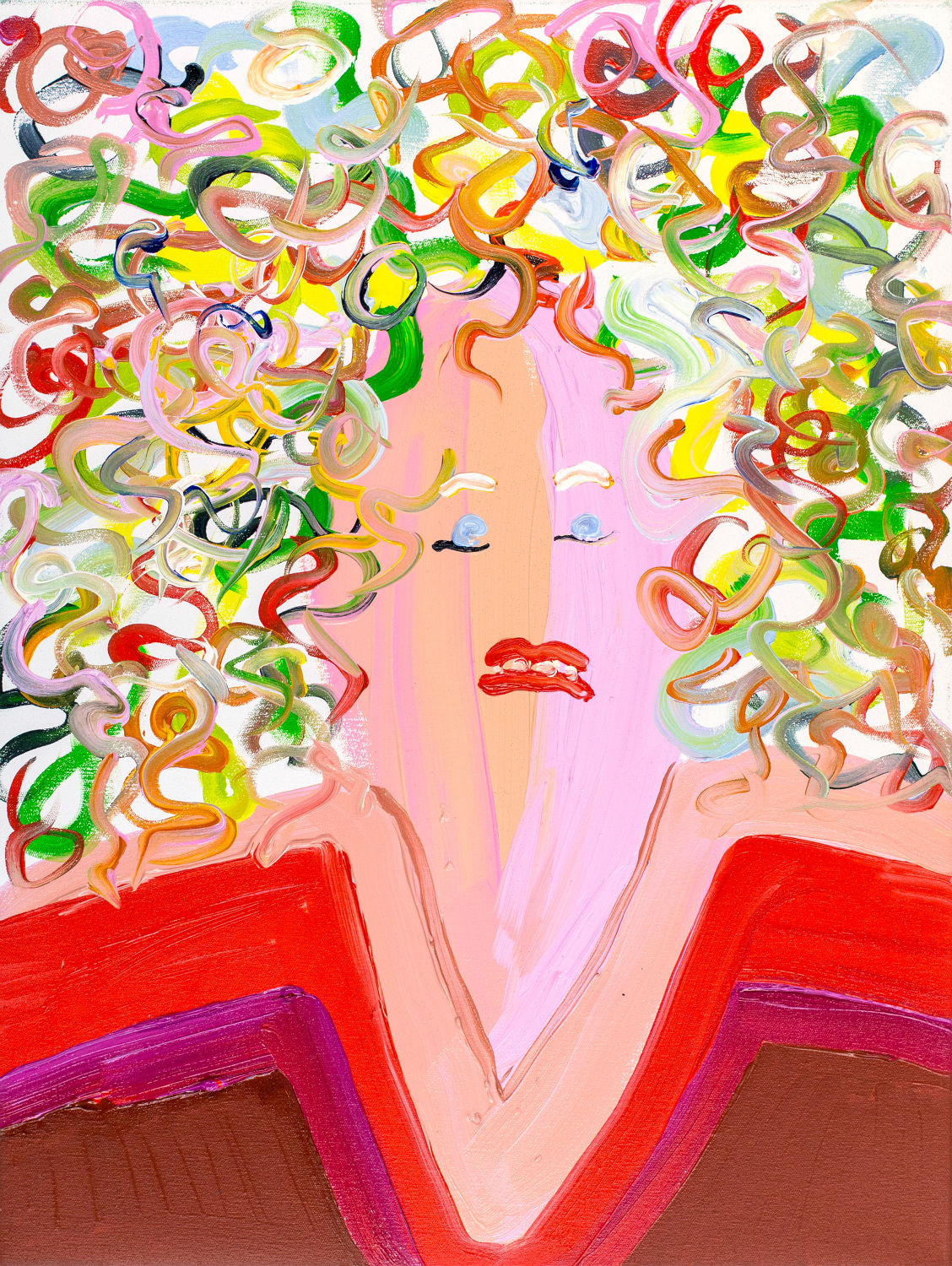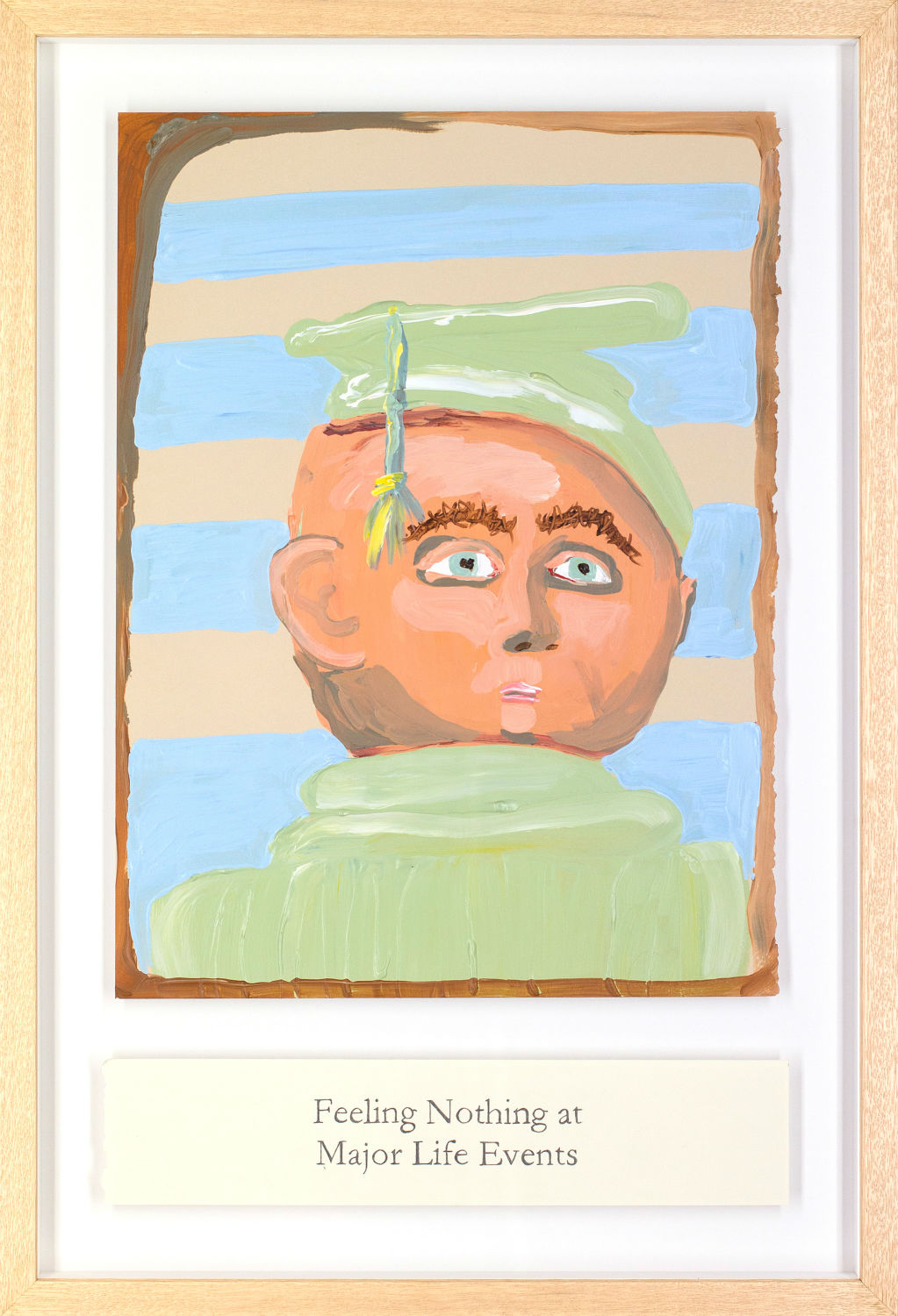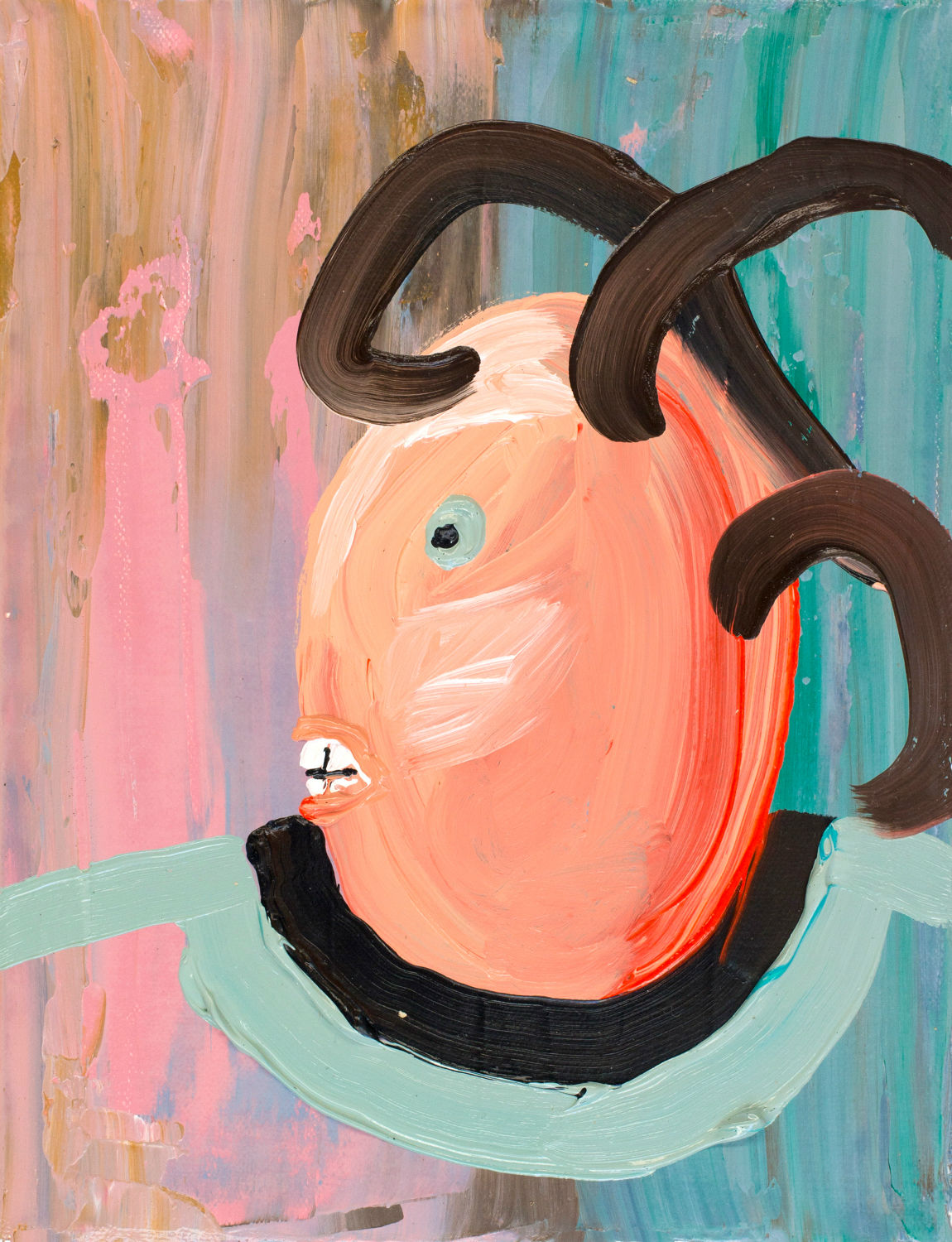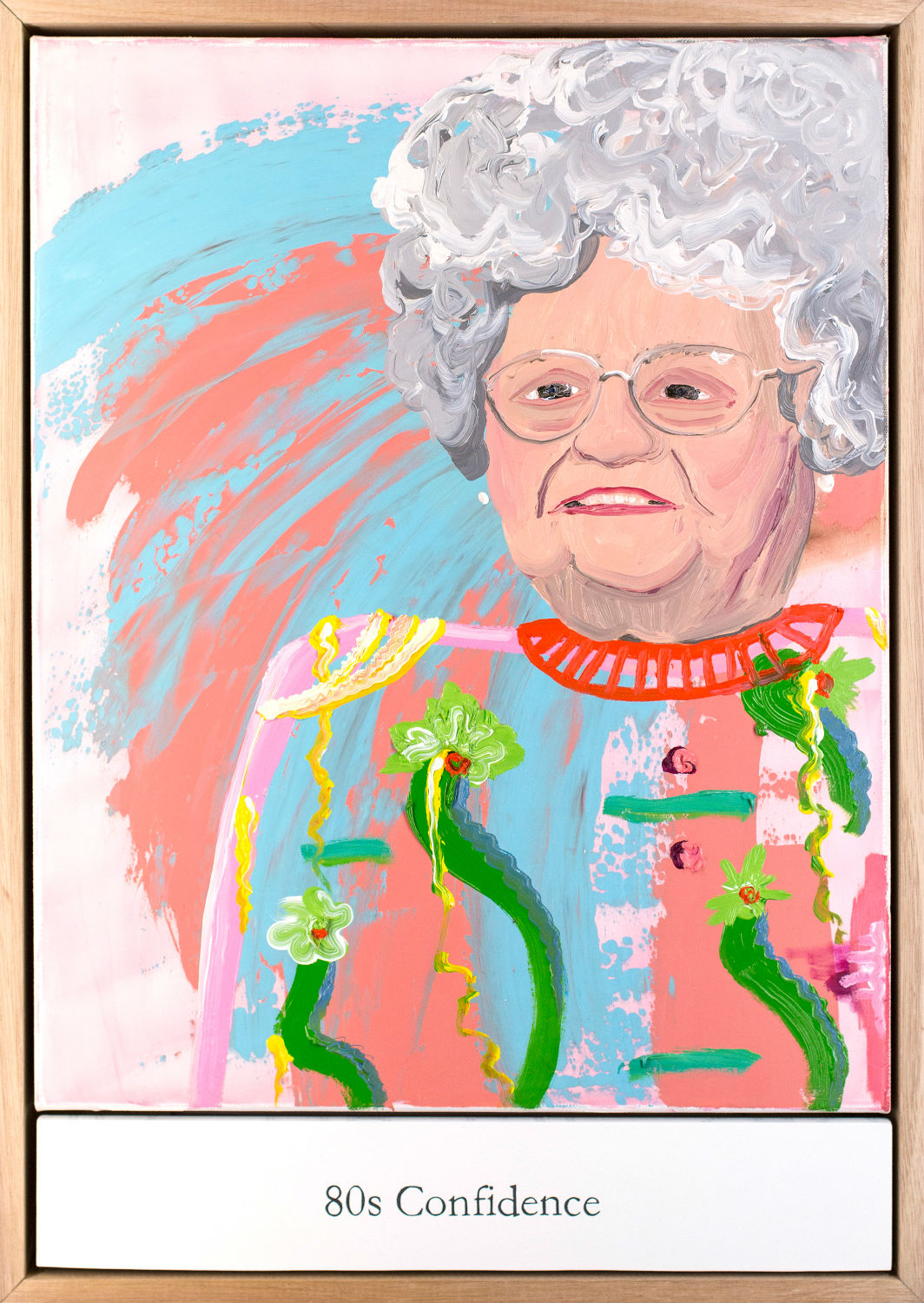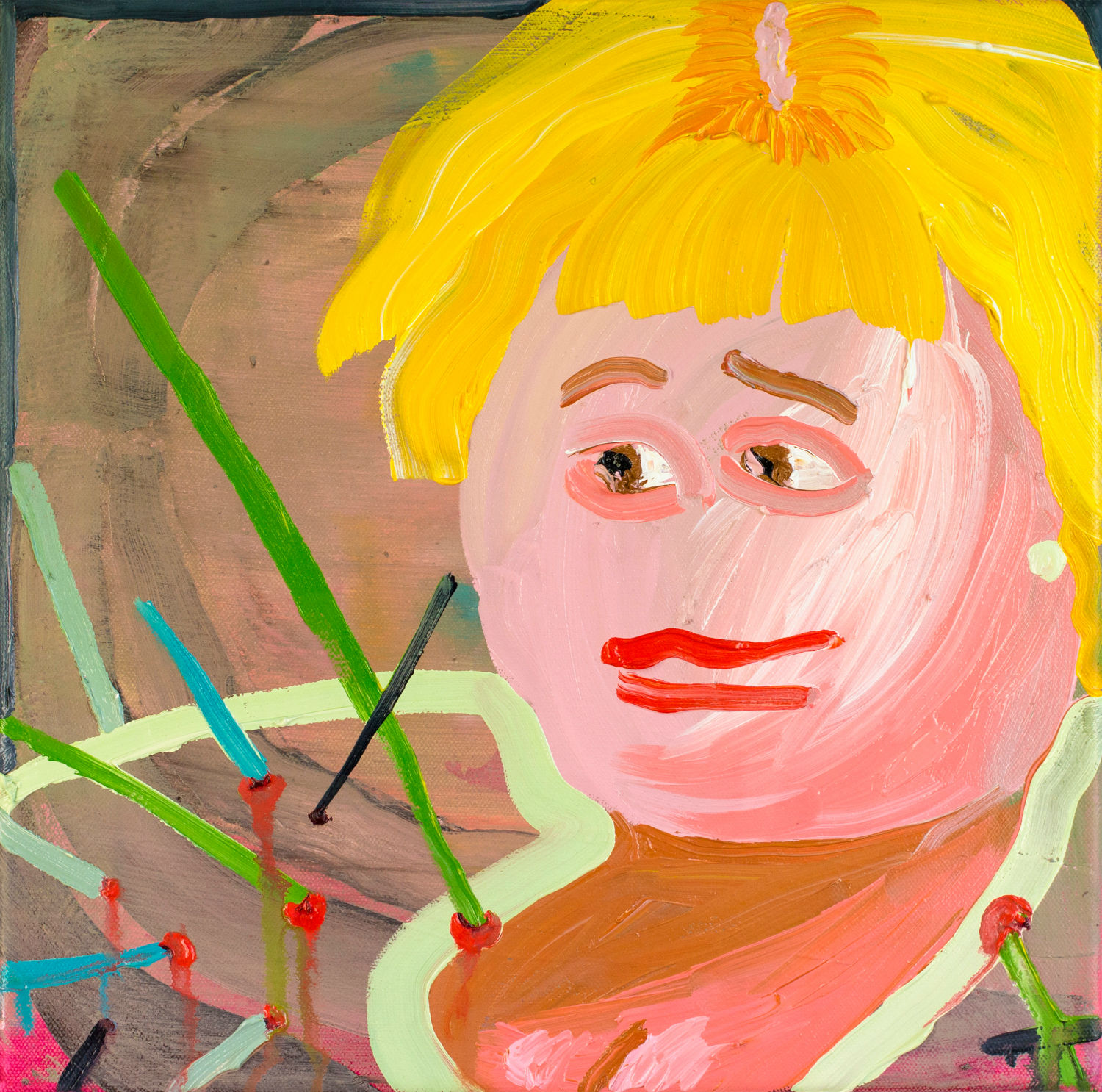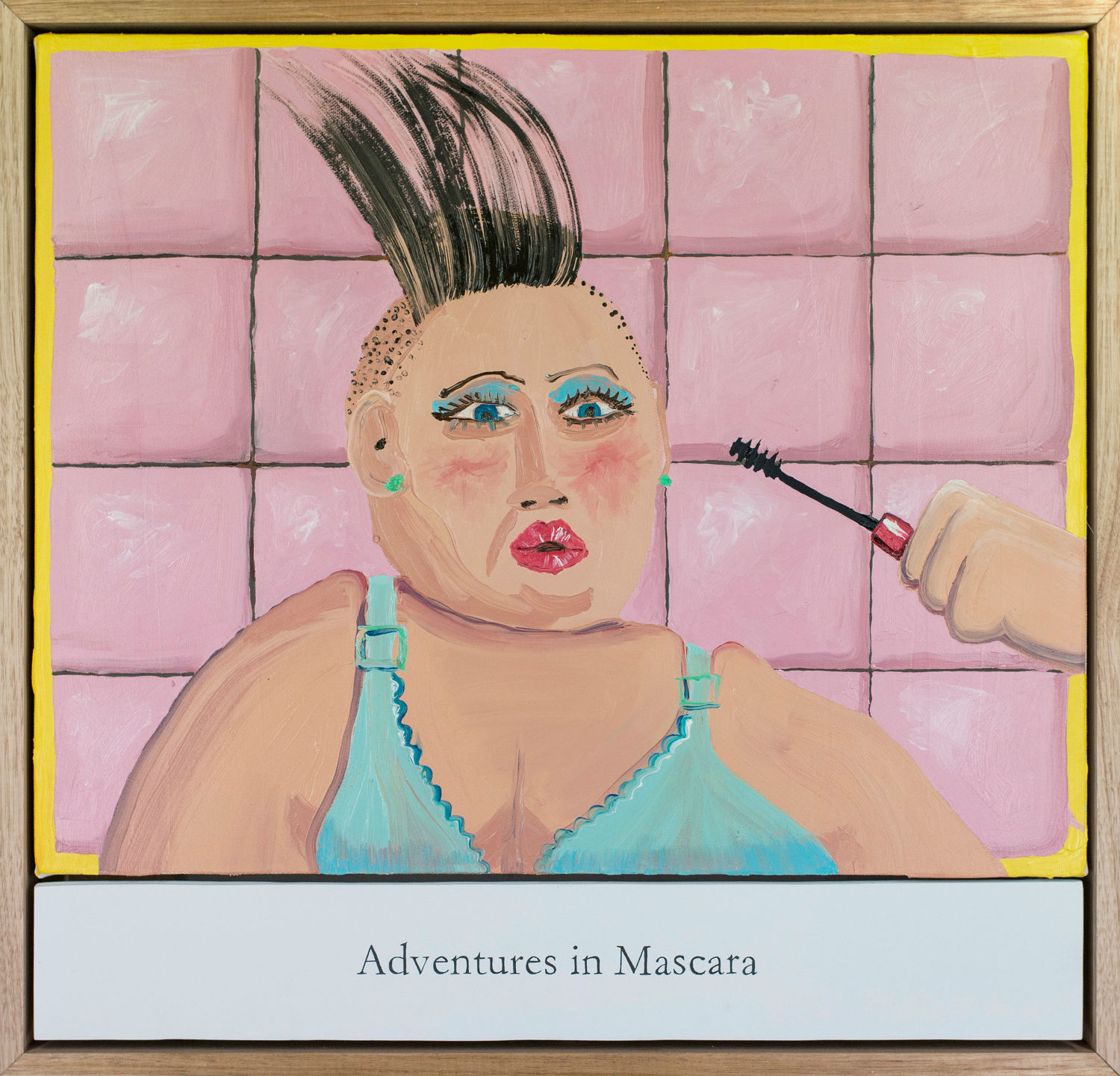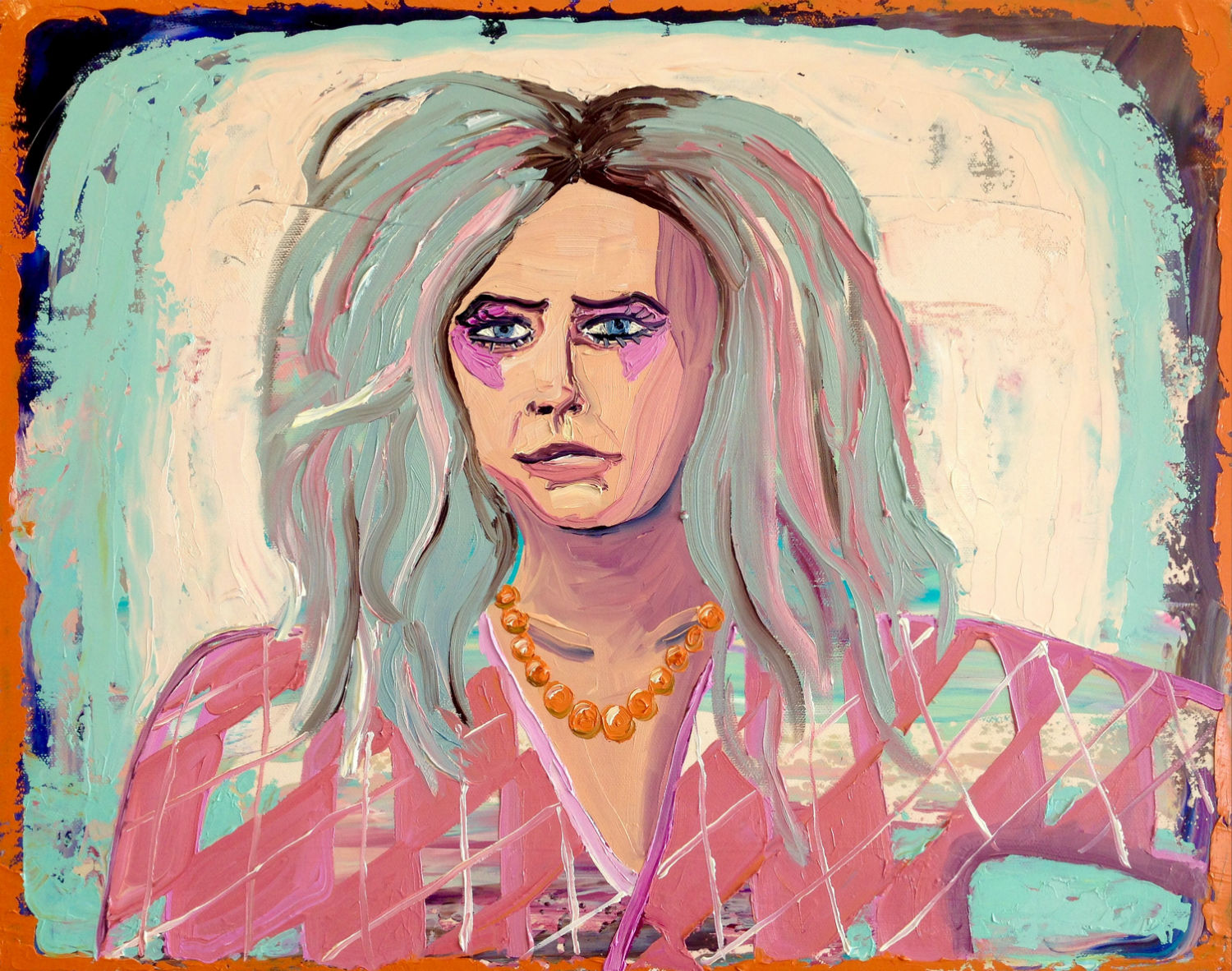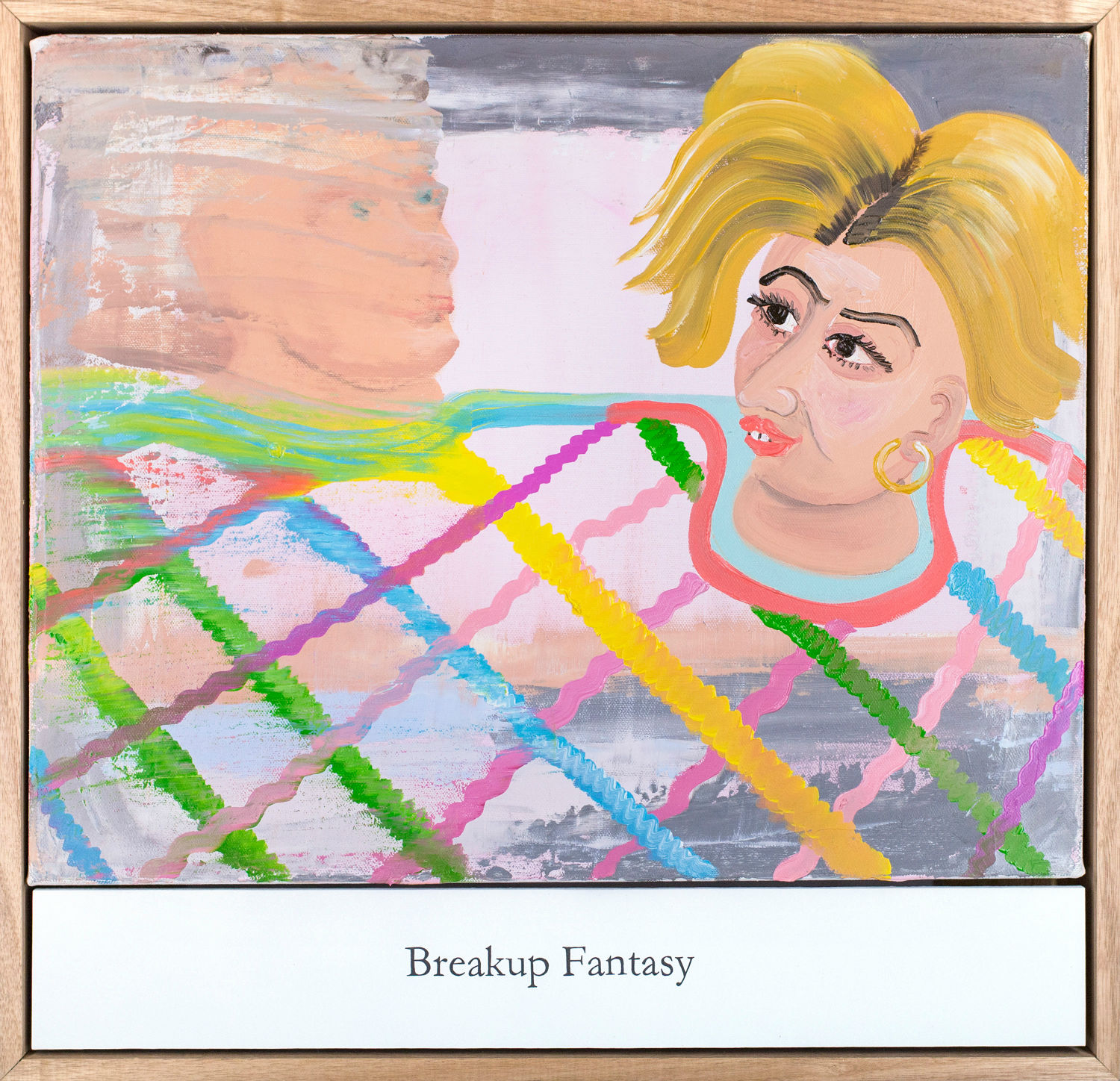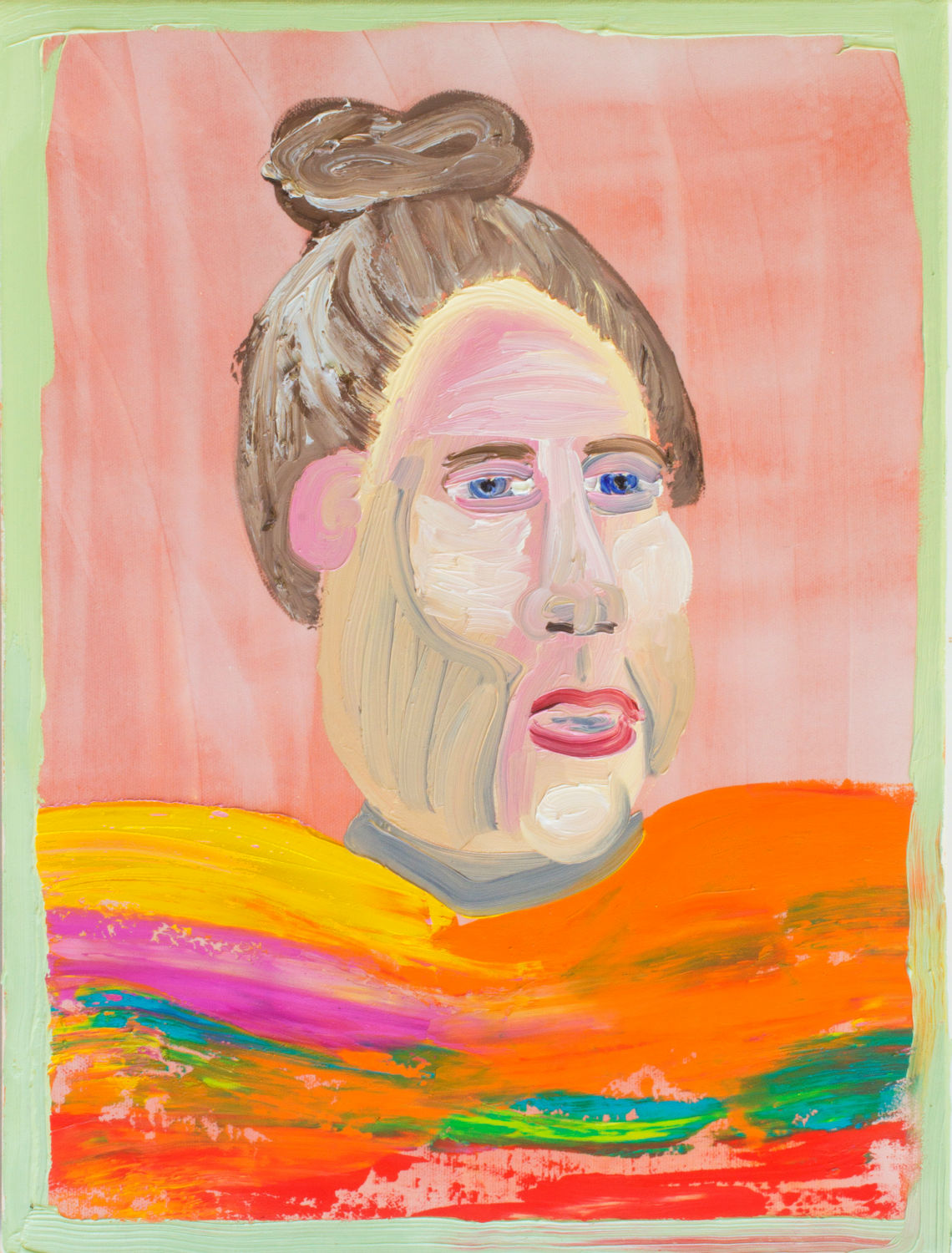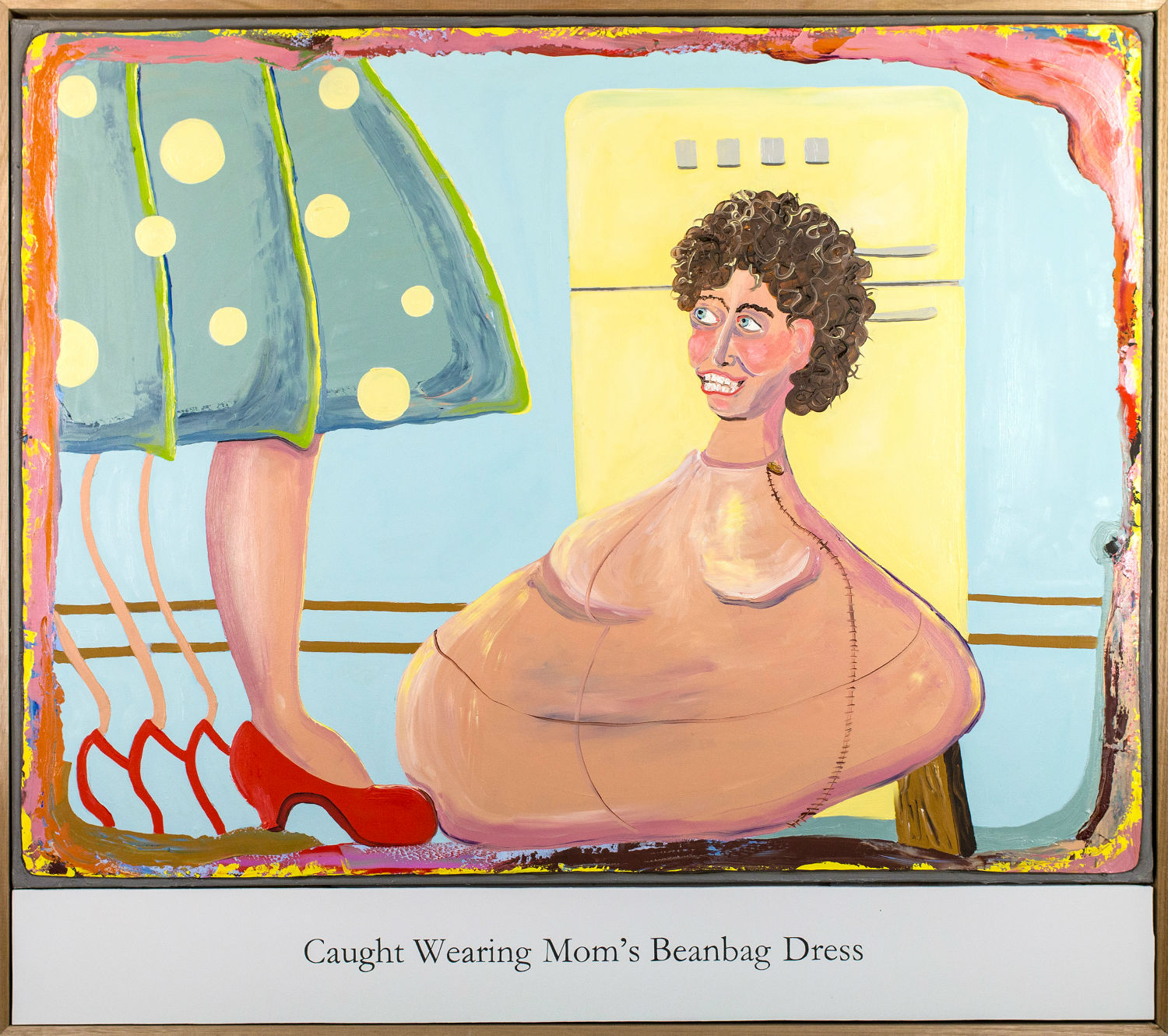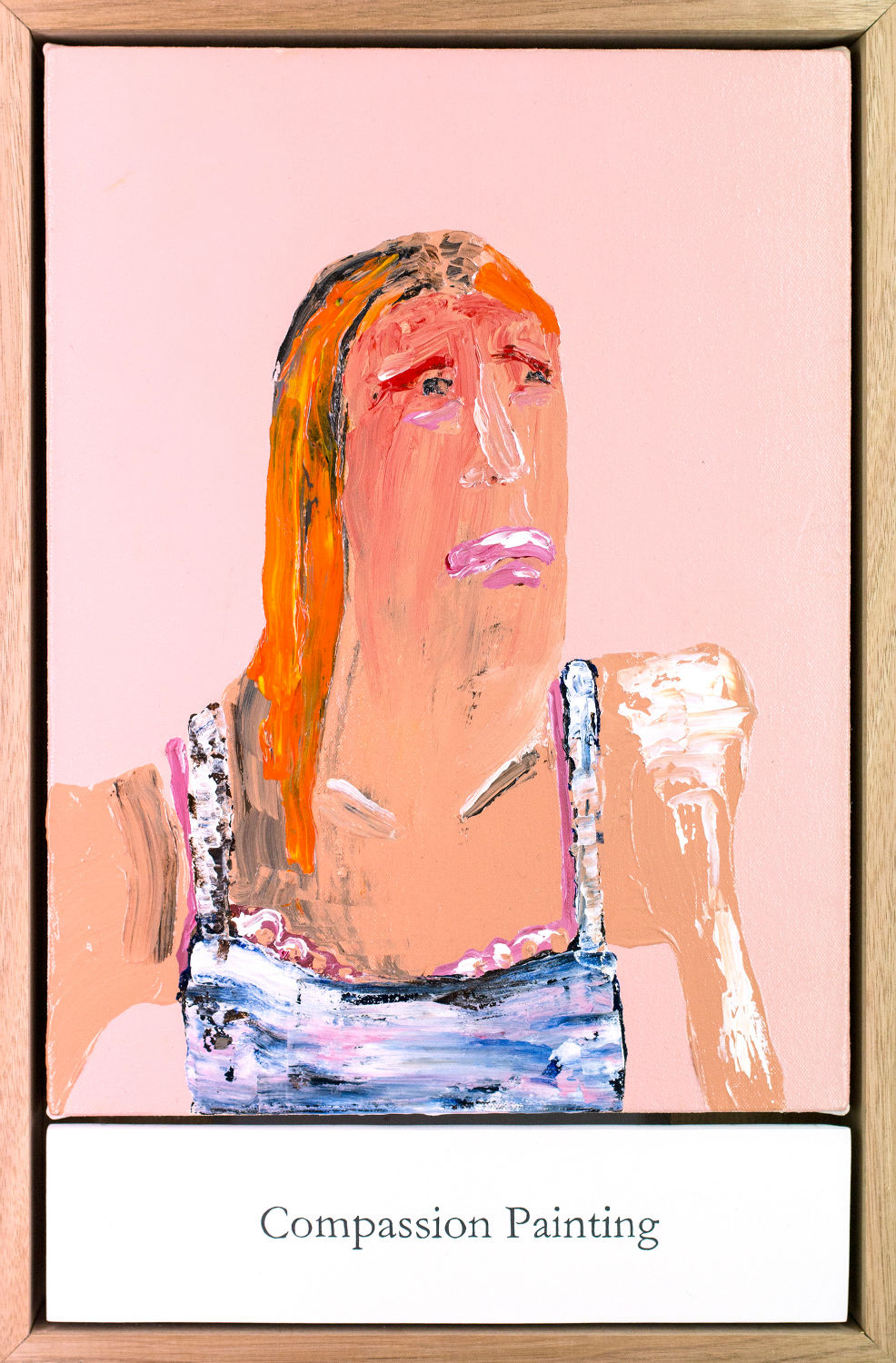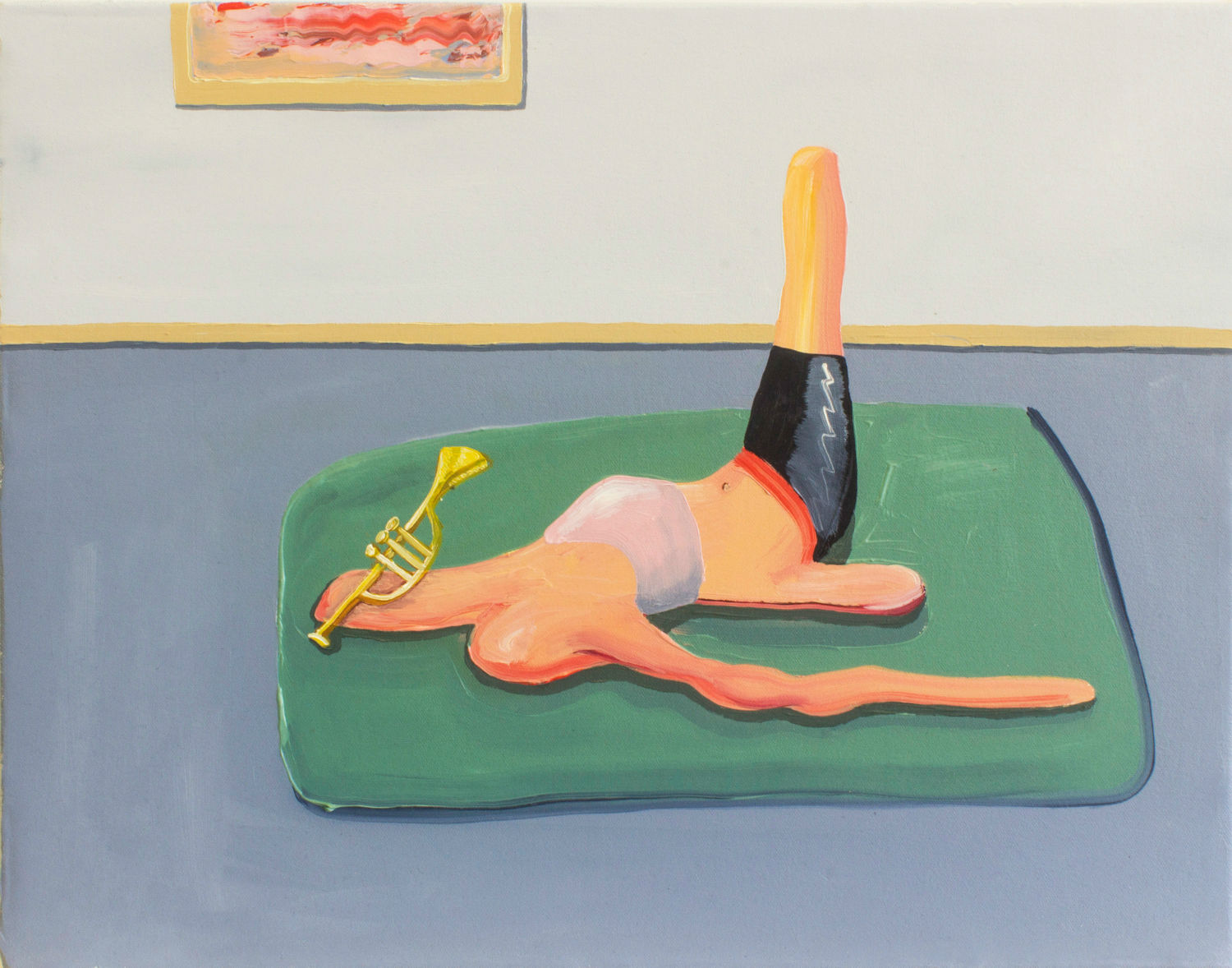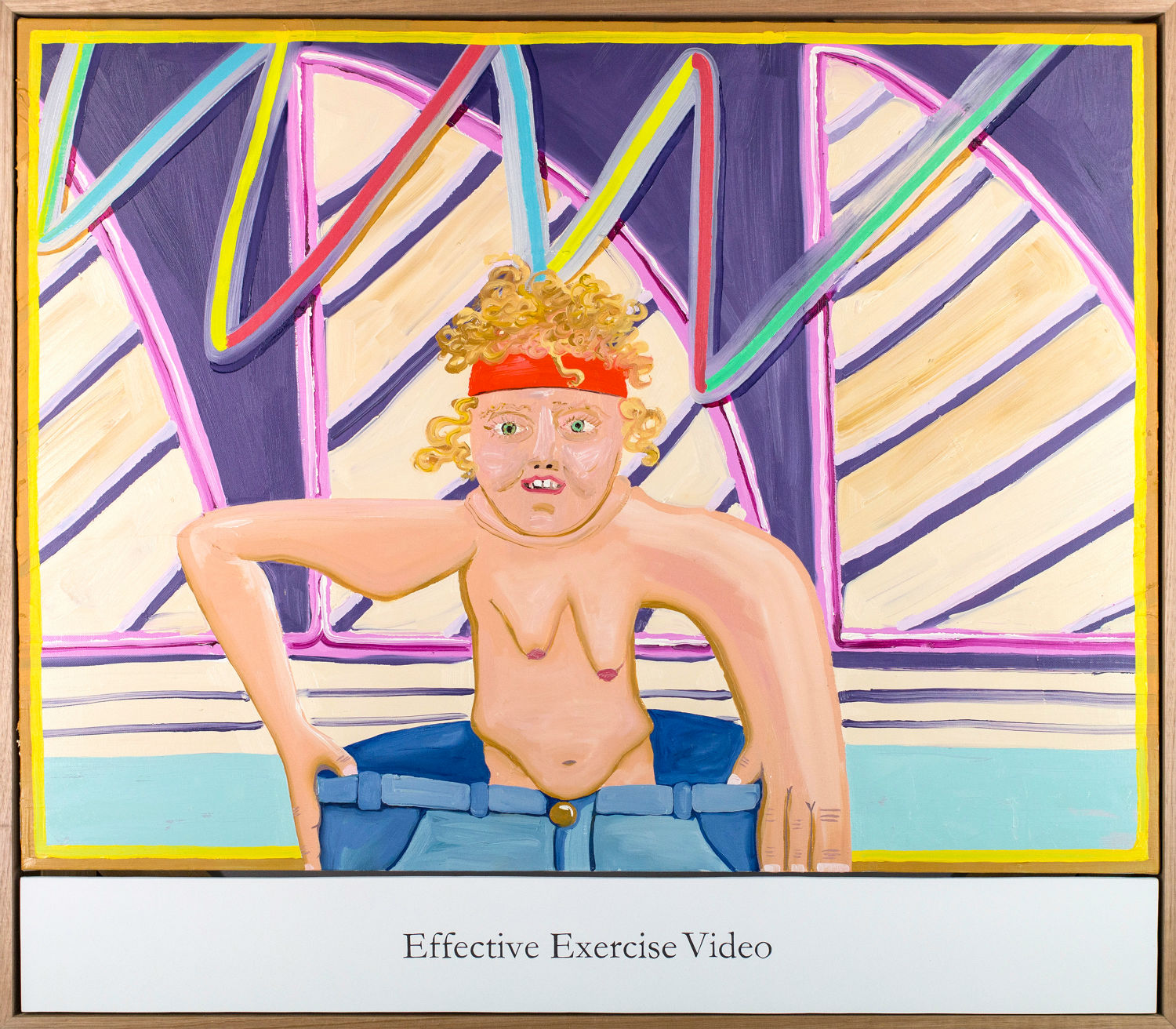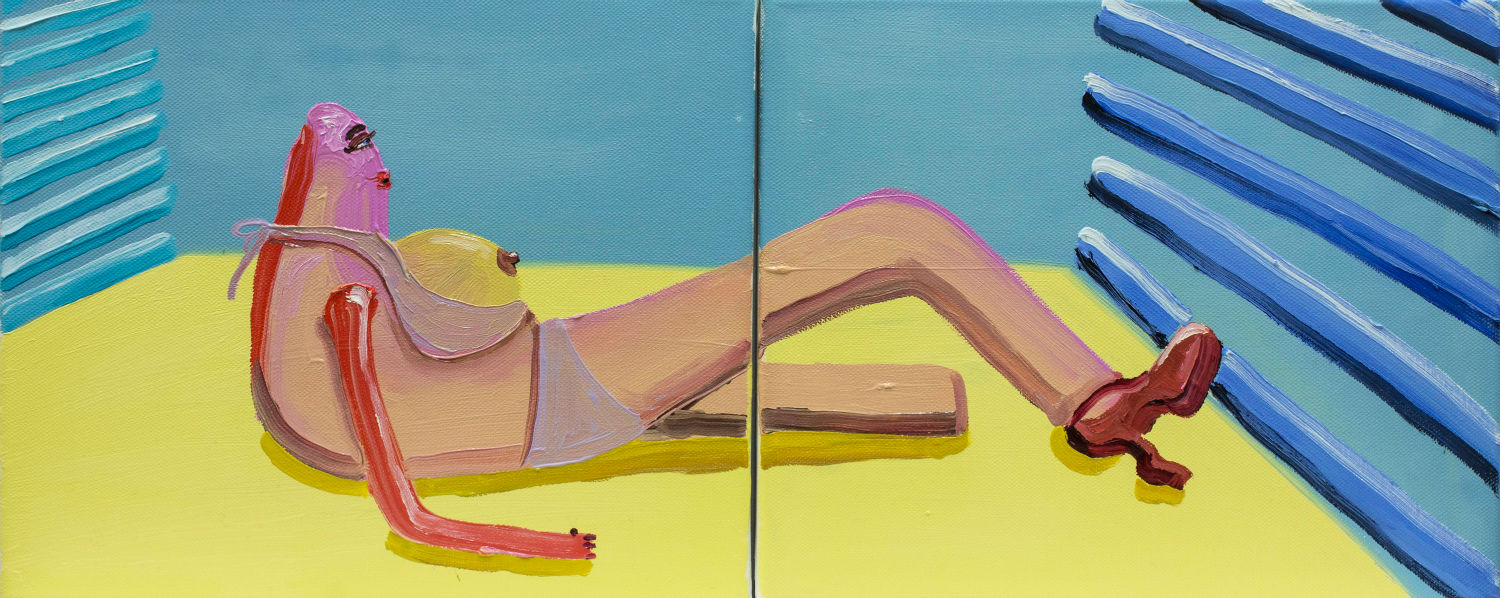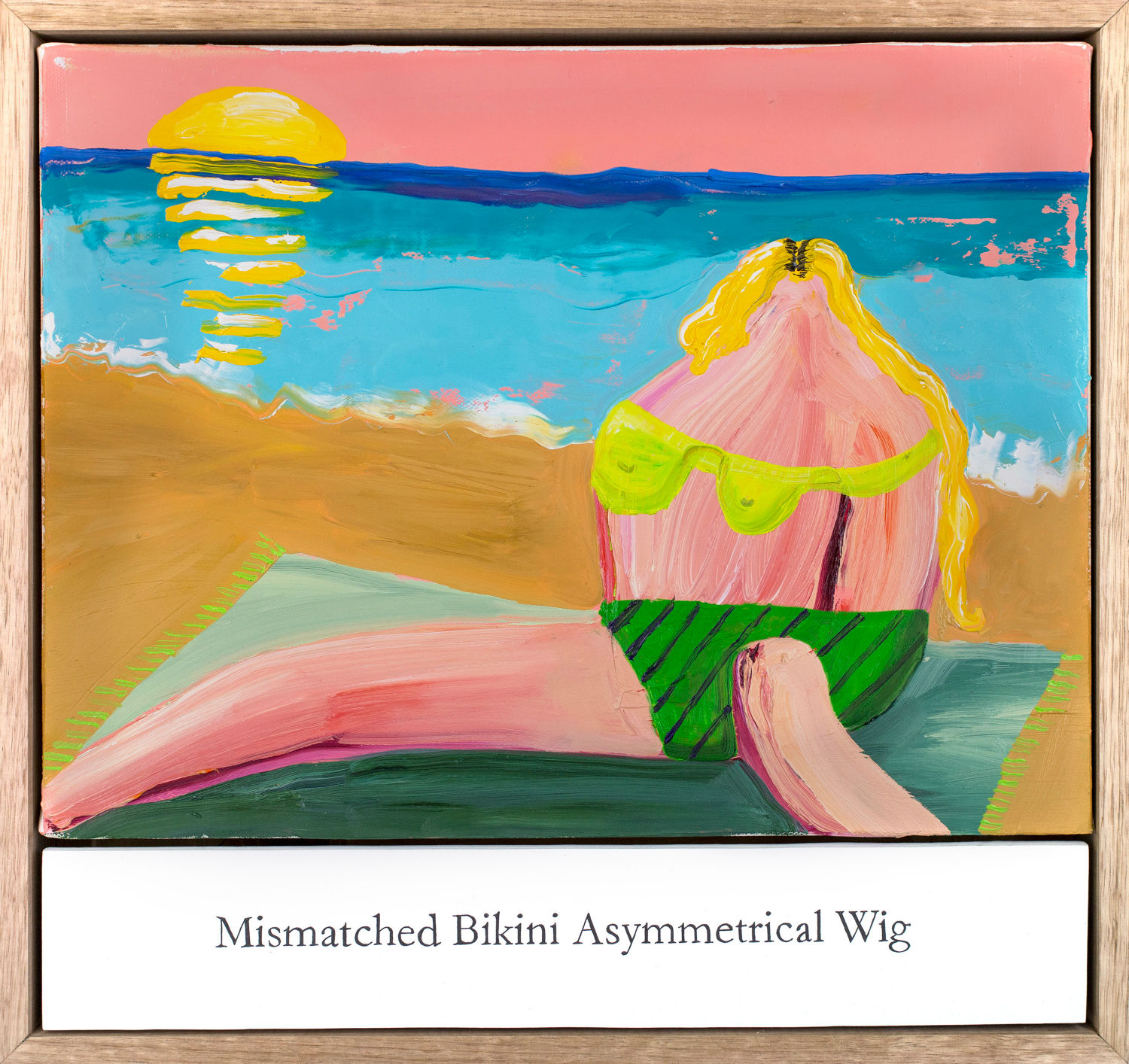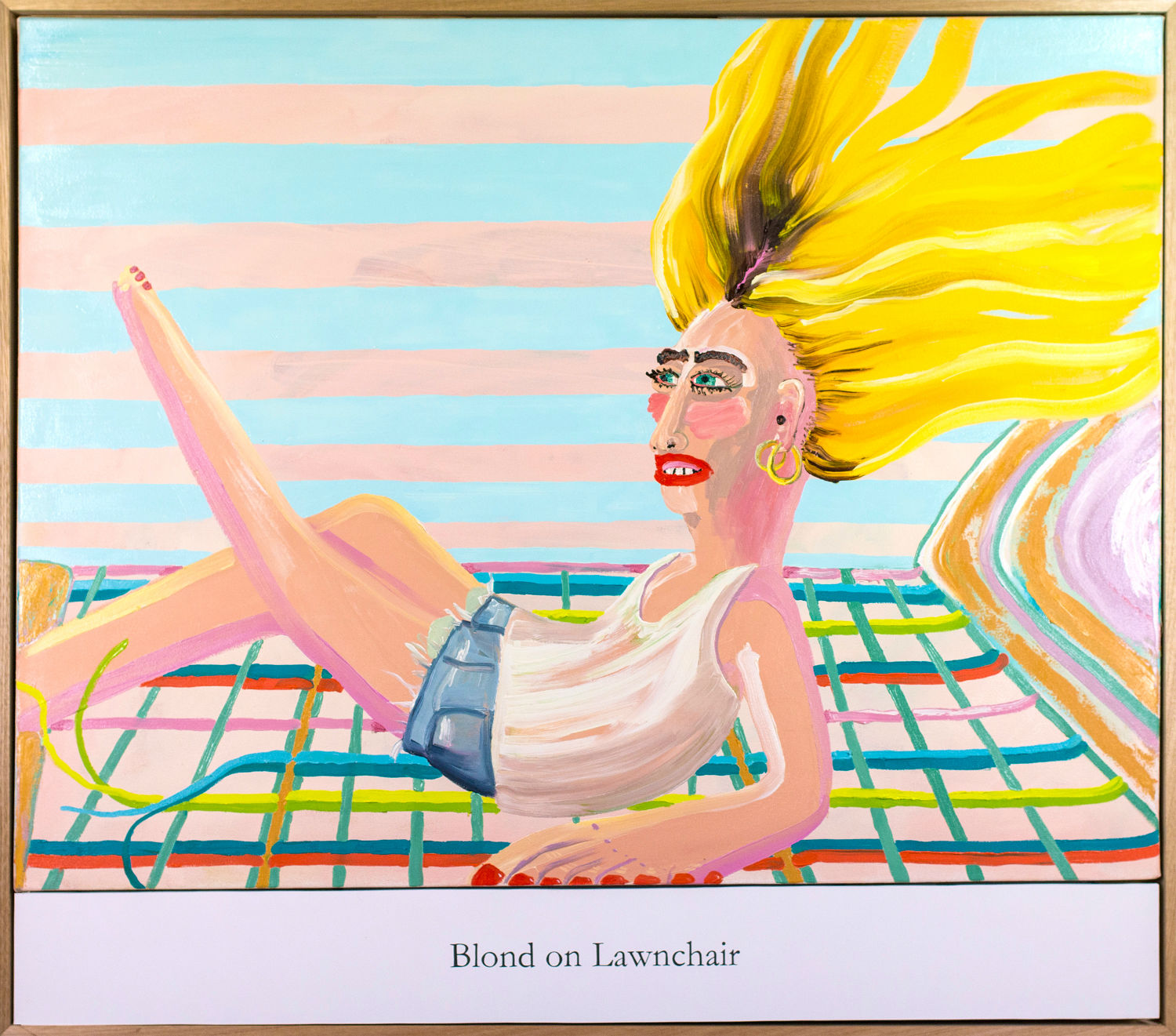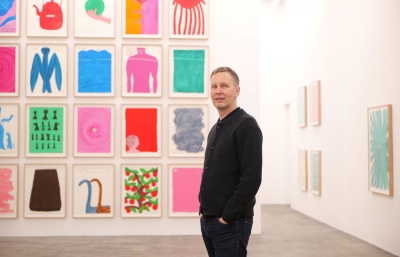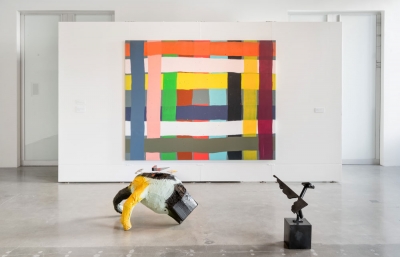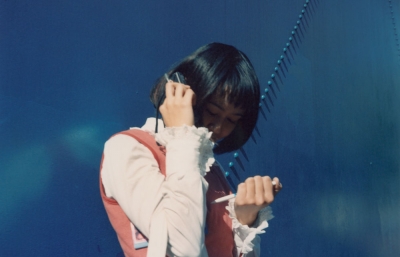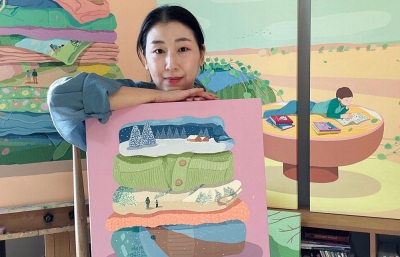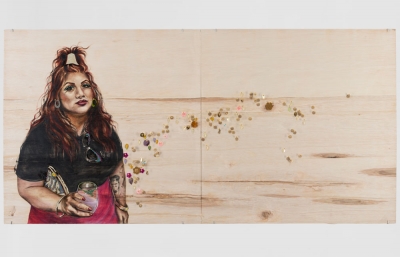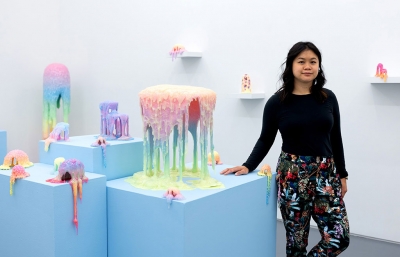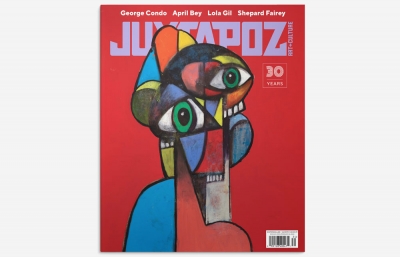Amber Boardman works intuitively to paint feelings and nearly abstracted portraits of oddballs. Inevitably influenced by the pop cultural zeitgeist, she explores beauty ideals, intimacy, and the most prominent peculiarity of contemporary life: awkwardness. She recently made a triumphant return to the easel after many years in animation, and Dr. Boardman is now a painting outlaw on her way to a PhD in cartoons. She was born back East and now lives Down Under.
Read this feature and more in the January 2017 issue of Juxtapoz Magazine.
Kristin Farr: What are your current obsessions and themes in painting?
Amber Boardman: I try to look at the normal things people do, but with a curious mind, and then I imagine ways I can characterize them. An example is my long-standing fascination with women’s beauty rituals and the industry around them. I think of the women I paint as artists who use makeup, spray tan, hair dye, plastic surgery, etc. as their art mediums. I’m also exploring their motivations. My characters are usually insecure and have anxiety about looking good or being fashionable. I’m especially interested in how people can distort their bodies to look better but end up looking grotesque. It’s important to note that I’m not making fun of these characters. I have sympathy for their feelings of insufficiency, but I don’t exactly share them. It’s like holding up a mirror to normal behavior. When you really look at something commonplace, it starts to seem pretty strange.
I’m obsessed with creating characters with unique personalities. I’m also obsessed with weird things like neck braces. I guess it’s because of the awkward way people have to turn their head when they move. I love painting distorted bodies, weird skin tones, body hair, pimples; the things people want to cover up. But these things can change over time. Having your roots showing used to be a no-no. Now it can be seen as cool or edgy.
A theme I’m concerned with at the moment is the interaction and tension between two characters. It’s different from single portraits because the feeling between the two people becomes a character in itself. In Kiss System, I tried to imagine the feeling between two people kissing, which catalyzes a Rube Goldberg machine of affect.

Are any of your figures self-referential?
It’s my vision of what’s around me, but mostly these characters aren’t me. I do have one self-portrait called Middle Aged Selfie Hand Knitted Sweater. I like the idea of a selfie being a painting made at arm’s length, rather than a photo taken at arm’s length. I was imagining myself older, retired and bored, taking up knitting and making sweaters. But because this selfie takes place in a world made of paint, the sweater is really just some abstract smears of paint “knitted” by a paintbrush. In general, I love turning sweaters and hair into abstract paintings. Sometimes portraits are just an excuse to create abstraction. The faces becomes an anchor point and I can really let loose on the clothing.
How do people feel when you make a portrait of them?
My boyfriend just looked down at his armpit and asked it to respond. The armpit replied, “pretty good,” in a fake falsetto girl’s voice. So there’s your answer. He’s referring to Portrait of Sweetie’s Armpit.
I don’t often make portraits of real people, they are almost always imagined. But the people in my life know that I get inspired by what happens around me. Sometimes they’ll tell me a funny tale of what happened to them in the grocery store, or all about the unique choreography that takes place while you’re getting spray tanned. They’ll say, “This sounds like one of your paintings!” perhaps hoping I’ll paint what happened to them. There was a time when I saved all of my voicemails and made songs and animations out of them.
If your subjects talked, what would their voices sound like? What music would they be into?
It totally depends on the character. I finished a painting last week where I considered clarifying through the title that the woman has a New York accent—a really raspy one. Most of my characters have more colloquial ways of speaking. There’s not much elite private school proper speech happening. Slang abounds.
Some of them listen to the peppy mall dance music. You know what it’s like when you’re in a mall when it’s not busy? No one is in the store but there is this overly loud upbeat music playing to make you feel happy and excited about buying new clothes for going out on the weekend? That forced cheer effect is what I’m going for with the younger characters. My middle aged characters mostly listen to smooth FM. Streisand. Carly Simon. Ambrosia.

Maybe some Phil Collins. What’s a specific visual that has inspired you?
I once saw a woman standing on the bus, her arm wrapped around a pole because there were no seats free. She spent the entire 40-minute bus ride on her bathroom routine. Makeup, hair, deodorant: the whole thing. It was interesting watching a stranger perform things you would usually only see if you were her lover. I thought her casual nature in front of all of those strangers was an engrossing display of intimacy. Either that or there was an I-don’t-give-a-fuck-ness about it that I found appealing. Savage. I was in suspense imagining what might happen if the bus hit a pothole while she was applying lipstick or mascara.
Does Pedicure Bike Commute have a backstory?
It’s another painting inspired by the odd things women do. When I was living in New York, I used to love seeing women dressed beautifully but, in flip-flops and those toe-separator things, walking out of some pun-titled salon like You’ve Got Nail. I like thinking about the very small details of life. Like the factories that make toe separators and the designers that figure out the optimal one-size-fits-all for toes. It’s an odd little contraption that relates to a very specific part of the body for one single weird purpose. Plus they sort of look like brass knuckles. Love that.

What about IUD Ashtray Bottle?
I don’t usually paint still lifes but I thought it would be fun to paint objects that would be inappropriate for a traditional still life. The stuff no one would want to paint. I was also thinking of how I could tell a story about an off-screen character with just some objects on a table. This might seem graphic (especially to all you IUD wearers out there, myself included) but I was imagining someone being really cavalier, saying, “fuck contraceptives!” and just ripping their IUD out and throwing it in an ashtray. Maybe it’s been there for a while, and now there is a need for a baby bottle because she got pregnant as a result. Or maybe it was never inserted in the first place. There are lots of ways you could read it.
What’s your general approach to sexuality in your paintings?
Glad you bring this up because it’s fun to talk about but not many people want to go there. In general, I’m interested in the moment when something breaks down into its opposite. Take porn, for example. It’s meant to be titillating but there are these moments when the camera gets too close and it’s just abstract slimy parts moving around. I made an animation about that years ago called Inside.
Perhaps the women out there can relate to the vibe I was going for in Exam. There can be a razor-fine line between something stimulating and something uncomfortable.
I’m interested in the ways people try to make themselves attractive. I’m fascinated by really extreme plastic surgery. One now-illegal procedure involves having string laced through breast tissue. The irritation causes your boobs to keep filling with water so you have to get them drained regularly or they will explode. How amazing is that?
Barf! Do you feel like your paintings have a dark side?
I try to balance out dark and light in each painting. I’ve found that how they’re interpreted says a lot about the person looking. In one of my exhibitions, I watched people walking around the gallery just cackling! They focused on the humor. And in the same exhibition, a friend said to me gravely, “These are really dark!”

Why was it important to start displaying your titles framed with the paintings?
I had an exhibition earlier this year where people had to walk around the gallery following a numbered exhibition list to figure out what the titles were. That seemed really complicated and indirect, especially during the chaos of the opening. I kept saying to my friends, “You gotta get the list and look at the titles—they’re so important!” Then a friend presented this frightening scenario: “Ten years from now, one of your collectors may be sitting around drinking with friends, point to one of your paintings and say ‘Great painting. It’s called Major Life Events.’ But the actual title is Feeling Nothing at Major Life Events, which gives the picture a very different meaning. Don’t let that happen!” If you get the title wrong, it either doesn’t make sense or it dilutes the impact of the piece. I wanted to experiment with ways of making one complete work, an inseparable title and image. I’ve been thinking a lot about The Far Side comic as well as internet memes. The captions are essential. It’s the same with my work.
Do overheard phrases often end up as titles?
I file things away somewhere in my mind, and they resurface as I’m painting. I’m fascinated by fads in general, whether in language or image. My painting, Resting Bitch Hair, is an obvious reference to the phrase fad “resting bitch face.” Another example I can think of is a collaborative painting with artist Teelah George. I painted this woman who looked slightly anxious, slightly horrified and definitely uncomfortable. I wanted a title that would capture the feeling of being out of your element. I titled it Introvert at an Extrovert Rally. The phrase just sort of came to me and then I realized it was inspired by a joke from Family Guy where Stewie says, “That’s like a crocodile at an alligator rally.” Look it up. It’s worth your time.
I did. “What a croc!” Speaking of cartoons, tell me more about your music-related animations.
I’m a closet musician, myself, and often visualize scenes, colors and atmospheric information when I listen to music. I think of my animations as visual representations of music. One of my pieces, The Garden of Love, was a companion work to Dutch composer JacobTV’s Concerto for Boombox and Flute. Now musicians play alongside my animation live onstage all over the world! Great project to be a part of.
I can tell William Kentridge is an influence.
Seeing Kentridge’s work changed my whole direction when I was in college. I was so excited to find out that animation could also be art. I think he was really the first artist to bridge that gap. I loved the idea that I could make my characters move. I was a painting major at the time of seeing his films, but I had a teacher named Joe Peragine who taught us how to make rudimentary animations in Flash. I found it really difficult and I almost dropped the class. But a friend gave me some extra pointers and I was totally hooked. Incidentally, that friend and I both ended up getting jobs animating for Adult Swim a few years later.
Tell me about working there.
An incredible experience with wacky and talented people. There were jokes and foosball games going all the time. Of course we worked really hard too. To meet deadlines, we often worked days on end. I vaguely remember having a nervous breakdown in the bushes outside the studio, calling my mom crying after not sleeping for two days. People’s marriages broke up. It was intense. It made me feel better to learn that the Disney guys all ended up in the hospital trying to get Snow White out the door in time for the premiere. Animation is not for the weak. I learned so much about drawing, motion, time, and what I was capable of accomplishing. It made me a better artist. The first show I worked on was Squidbillies. We had to draw these morphing tentacles, and I loved how we could make them stretch and do whatever we wanted. I possibly do that now with paint as a result.

So, for a while, you completely left painting for animation.
It was partly due to my MFA in New York. I couldn’t shrug off what I perceived to be cool around me. Painting seemed so boring. So traditional. Now I think of painting as unencumbered and immediate. It forces me to take risks and be vulnerable in saying what I want to say without the filters that come with planning and technology in animation.
How did it feel to get back into painting, and how was your work different when you picked it up again?
I felt shy and guilty about it because I had denounced painting. I wasn’t sure if I’d ever be let back into the club. It seems so ridiculous now! If painting police exist, I’m an outlaw for sure.
The new paintings actually have a lot in common with the way I used to draw in my twenties. I was making up characters all over the place back then, but I didn’t think they were serious enough. Ah, youth. My paintings are a lot more confident now. And weirder. I try to let my inner weird really fly these days.
I love School Photo With Lasers and Turtleneck. I had that laser background in my fifth grade photo.
I don’t know who was responsible for the school photo laser movement but they deserve recognition. Such an inspired move. The person in this painting isn’t me, but obviously you know what my answer was when it was my turn to have my photo taken: “Do you want a pink background, a blue background, or lasers?” Enough said.

Why do you have a tendency toward painting eggheads?
That, my dear, is a mystery even to me. Sometimes I wonder if it’s related to something I read in Siddartha years ago. As you grow and change in life, you break out of your shell to see that there is a whole world outside you didn’t know existed. Life is a series of shells you keep breaking through. I also like that eggs are both very strong as a whole but if you put pressure on a small surface area, they are quite fragile. Humpty Dumpty is a character that morphs in and out of my paintings. A fallible being heading towards entropy but trying to enjoy the ride.
Do you do any sketching or are your paintings all spontaneous?
I never sketch anything. There is a mysterious or magical part of my process that I don’t entirely understand but I’m sure a lot of people can relate to it. It’s that part of creating something that doesn’t feel like it totally comes from you. Perhaps it’s from the collective unconscious. My process begins with mixing lots of flesh tones and a few other colors on my palette. I put a blob of paint down and then I start asking questions. Does that look like a face? An arm? I keep following this line of questions, but I also feel that I’m not entirely in control. I let the paint lead. As the painting progresses, I ask different questions: Is this the face of a person who is satisfied? Anxious? What are they thinking about and what are their concerns? What is their family like? Who are they trying to impress? I want to create individuals with consciousness that comes from a world made of paint, and the rules of this world are governed by that fact. So if I’ve painted two people who are in a relationship and the woman wants to break up with her man, I can just scrape the paint away. Done. Relationship’s over. But the history of the mark-making remains, similar to our world.
Mind blown. No wonder you’re in the middle of a doctorate. Is it a PhD in awesome?
It’s actually a PhD in cartoons! More specifically it’s about the influence of cartoons on contemporary painting—a fun synthesis of my backgrounds in painting and animation.
----
Originally published in the January 2017 issue of Juxtapoz Magazine, on newsstands worldwide and in our web store.

